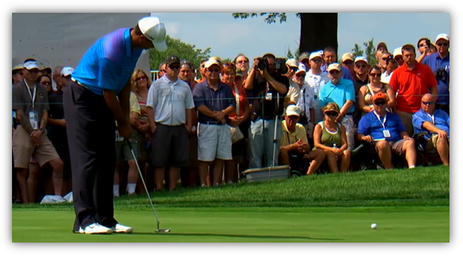“Any sufficiently advanced technology is indistinguishable from magic.” - Howard C Clark I don’t know any serious amateur or professional golfer who doesn’t want to learn how to break par often. But learning how to break par for many golfers seems to be as mysterious as a great magic trick that has you scratching your head wondering how the magician just pulled off the great illusion before your very eyes. Breaking par can truly seem like a magic trick but believe me it isn't, because it is achieved by many golfers from young to old who have developed their game to a very high standard. These golfers employ certain specific strategies and skills that set up low scores more often, and you can learn how to as well.  First You Need the Par Breaking Mind-Set The one thing all self-made millionaires have in common is that they want to be rich, they want to earn lots of money because they are motivated by the things that lot’s of money can give you; personal security, freedom from bills, bright shiny objects, lots of vacations etc. And the key to their success is that they think about being rich all the time; they think about growing their wealth; and they go to work on it every single day learning the specific skills, knowledge and strategies that makes it possible. They have what is called "the millionaire mind-set." In other words they focus their energy entirely on generating and increasing their wealth, and from there they work out how they will get it done! Turn the Idea of Breaking Par into a Belief To be a par breaking golfer you also need to think about breaking par often. It must be forefront in your mind and you need to be continually finding creative ways and means to achieve it. This is what every low scoring golfer does; they continually focus their energy on reducing their golf scores by reducing the mistakes in their rounds that makes it more difficult to break par, and they seek out the teachers, coaches and mentors that can help them achieve it. They believe that they can break par often, it is not a fantasy, it is reality because they make it so. And it is not something only mature golfers can do? There are many junior golfers under the age of 15 who can break par; so it is not a coming of age thing, it is possible for any serious golfer to learn how to break par with the right level of knowledge, skills and consistent practice.
Increasing your par average is the first key to breaking par often, and you will discover that crossing the 12 pars threshold will take you into new territory with your golf scores and will set you up to achieve your goal. Look at it like this; if you have 9 pars in a round, 3 bogeys and a double bogey, you would have to have 6 under in 5 holes to break par. You would need to have something like 4 birdies and an eagle, which is possible, but not probable. More pars per round just makes sense, and it also makes it easier to score low, doesn't it? The fewer pars you have in a round the less likely it is that you will break par. So how do you increase the amount of pars you generate in a round of golf? The simplest way is to reduce your bogey average and worse, and also increase your birdie or better average. Now I know that's obvious, but remember the par breaking mind-set I shared with you earlier? You have to focus all you energy on reducing bogey or worse in your rounds, and you need to build your game improvement strategies from this stand point to start with. Here's the key to remember; you should aim to have no more than 2 to 3 bogeys in any round of golf you play, and you need to almost completely eliminate double bogeys and worse from your game. Double bogeys and worse should rarely happen if you are going to be a par breaker.  What's Your Birdie to Bogey Ratio? On the PGA Tour the bogey average (2013 season) for the player ranked 1 was 1.96 bogeys on average per round, (just under 2 bogies) and for the player ranked 180 it was 3.4. The birdie average (2013 season) for the player ranked 1 was 4.22 birdies on average per round and for the player ranked 180 it was 2.80 birdies per round on average. Can you see a correlation between the amount of bogeys they make against birdies? If a golfer has 3.4 bogeys or worse per round and 2.8 birdies or better he will play over par. Now you are probably thinking that this is far from easy to do, and you would be right, but you need to understand that to break par often you will need to reduce the mistakes (bogeys and worse) that you make in every round you play. Here’s a really simple way of working out your bogey to birdie ratio so that you understand where you are in this critical game improvement area. Total birdies or better divided by total bogeys or worse. Let me show you what I mean. Tiger Woods ranked 3rd in 2013 for the birdie to bogey ratio statistic, and in the 61 tournament rounds he played on the PGA Tour he made 252 birdies or better, and just 163 bogeys or worse. 253 is a bigger number than 163 right? More birdies than bogeys right? When you divide 252 birdies or better into 163 bogeys or worse you get a result of 1.55. Remember that ranked him 3rd on the PGA Tour that year. If you go down the list from Tiger to Carl Petersen, Carl ranked 138 in this statistical category, with his birdie or better score 274 and his bogey or worse score also 274 resulting in a score of 1.00. This means that his birdies or better result was cancelled out by his bogeys or worse result. Go even further down the same list and Sean O’Hair ranked 177 in this important category with a birdie or better score of 173 against his bogey or worse score of 209, resulting in a .83 over par result. More bogeys than birdies. Can you see how important this is? I think you can see that the idea is to create more birdies or better per round compared to your bogeys or worse score if you want to break par often. Here’s a simple way for you to find out what your ratio is. At Pro Tour Golf College our formula for breaking par is described like this; < Par = Birdie or Better > Bogey or Worse You can create a table like the one below and track your pars and birdies or better in each round against your bogeys or worse and then using the par breaking formula work out where you stand currently. In the example above one of our golfers at Pro Tour Golf College had a Birdies or Better result of 27 and a Bogeys or Worse result of 45. When 27 is divided into 45 you get .60. (27 Birdies or Better ÷ 45 Bogeys or Worse = 0.60) I think that you’ll agree that this simple way to analyse your pars, birdies, bogeys and worse will help you to understand where your weakness lies. And when you understand your weaknesses you can make progress with well thought out and useful practice strategies. You see, before you go pulling your golf swing apart or changing some other aspect of your golf game take the time to understand your results against par and then work backwards from there. Next week in part 2 we'll take a close look at the way you should play the Par 3's, Par 4's and Par 5's to increase your par and birdie average and decrease your bogey and worse average by identifying the critical shot-making formula and key strategies that you need to learn that will help you to move your golf scores from over par and down into red numbers.
1/2/2014 10:59:08 am
Lawrie,David, 1/2/2014 12:17:15 pm
John,
Rio
1/2/2014 11:11:29 pm
David and Big Daddy Lawrie, Very nice article Mates,, Golf become fun with this progam. hv a nice day.... Comments are closed.
|
Archives
June 2019
|
Proudly Supported By
Copyright © 2011 - 2018 Pro Tour Golf College
Website Managed By Golf Performance Media
All Rights Reserved
Website Managed By Golf Performance Media
All Rights Reserved






 RSS Feed
RSS Feed



